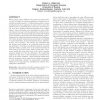Free Online Productivity Tools
i2Speak
i2Symbol
i2OCR
iTex2Img
iWeb2Print
iWeb2Shot
i2Type
iPdf2Split
iPdf2Merge
i2Bopomofo
i2Arabic
i2Style
i2Image
i2PDF
iLatex2Rtf
Sci2ools
112
Voted
PKDD
1999
Springer
1999
Springer
Heuristic Measures of Interestingness
When mining a large database, the number of patterns discovered can easily exceed the capabilities of a human user to identify interesting results. To address this problem, various techniques have been suggested to reduce and/or order the patterns prior to presenting them to the user. In this paper, our focus is on ranking summaries generated from a single dataset, where attributes can be generalized in many different ways and to many levels of granularity according to taxonomic hierarchies. We theoretically and empirically evaluate twelve diversity measures used as heuristic measures of interestingness for ranking summaries generated from databases. The twelve diversity measures have previously been utilized in various disciplines, such as information theory, statistics, ecology, and economics. We describe five principles that any measure must satisfy to be considered useful for ranking summaries. Theoretical results show that the proposed principles define a partial order on the ...
Related Content
| Added | 04 Aug 2010 |
| Updated | 04 Aug 2010 |
| Type | Conference |
| Year | 1999 |
| Where | PKDD |
| Authors | Robert J. Hilderman, Howard J. Hamilton |
Comments (0)

